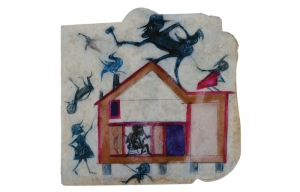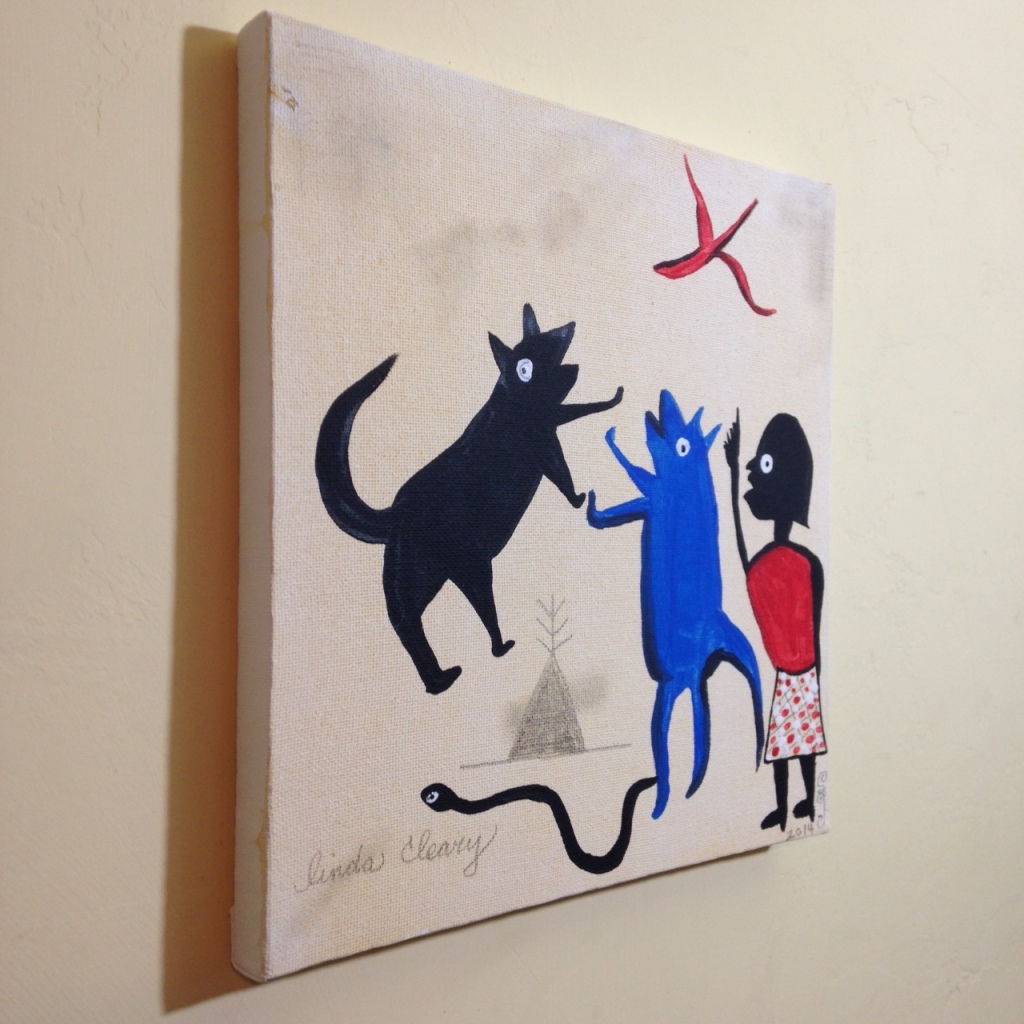It’s Day 92 and the sun is back out for a bit! Been feeling under the weather (literally with all those rainstorms!) and I’m feeling better and excited to go to improv tonight…hopefully, I don’t get struck again like I did yesterday. Sheesh. Well, I really enjoyed painting today so join me in honoring the wonderful Bill Traylor today.


William “Bill” Traylor (1854–1949) was an African-American self-taught artist from Lowndes County, Alabama. Born into slavery, Traylor spent the majority of his life working as a slave and sharecropper. It was only after 1939, following his move to Montgomery, Alabama that Traylor began to draw. At the age of 85, he took up a pencil and a scrap of cardboard to document his recollections and observations. From 1939 to 1942, while working on the sidewalks of Montgomery, Traylor produced nearly 1,500 pieces of art.
While Traylor received his first public exhibition in 1940, it wasn’t until the late 1970s, thirty years after

his death, that his work finally began to receive broader attention. Recent acceptance of Traylor as a significant figure of American folk and modern art has been founded both on the efforts of Charles Shannon, as well as the evolving tastes of the art world. Shannon, who first encountered Traylor’s work in 1940, brought Traylor to the attention of the larger art world. Since then, public and scholarly perception of Bill Traylor’s life and work has been in constant evolution. First held up as an example of “primitive” or “outsider” art, Traylor now holds a central position in the fields of “self-taught” and modern art.

Bill Traylor was born in April 1854, in Benton, Alabama. His parents, Sally (1815–1880) and Bill Calloway (1805–1860+) were slaves on the plantation of George Hartwell Traylor (1801–1881), a white cotton grower. He had five brothers and sisters, Liza (1837), Henry (1845), Frank (1846), Jim (1847), and Emet (1854).
For young Traylor, the mid-1860s marked a period of radical personal and economic

change. In 1865, Traylor witnessed the Confederacy’s loss to the Union. This social and political rupture was compounded by the death of his father sometime between 1860 and 1866. While the end of the war ensured his legal emancipation, Traylor remained entrapped in the economic structures of the South’s Jim Crow laws. He continued to work on the plantation, but now as a sharecropper.

While documenting the details of Traylor’s early life remains difficult, scholars have noted that Traylor fathered a number of children over his lifetime. In 1884, Traylor started a family with Larisa Dunklin (1872-). By 1887, they had had three children: George, Pauline, and Sally. By 1898, the couple had five more children: Rueben, Easter, Alice, Lillian, and an unnamed “child.” In 1887, Traylor fathered Nettie from another relationship. Additionally, in the late 1890s, Traylor took a second wife, Laura Williams (1870-). The couple had five children: Clement, Will, Mack, John Henry, and Walter. In 1902, he had a son named Jimmie, with another woman. Later in life, Traylor was quoted as mentioning that “he raised twenty-odd children.”
In 1935, Traylor left Benton for the capital city of Montgomery, 35 miles away. Explaining the move,

Traylor later remarked. “My white folks had died and my children had scattered.” For 82-year-old Traylor, it would prove to be a challenging new beginning. A year after the move, he found himself struggling to make ends meet. After rheumatism prevented him from continuing to work at a shoe factory, Traylor was forced out on to the streets. Receiving a small public assistance stipend, he entered into the ranks of the homeless. At night he slept the backroom of the Ross-Clayton Funeral Home. During the day, he camped out on Monroe Avenue. It was there, at the center of Montgomery’s African American community, that Traylor began his artistic career.
In June 1939, Charles Shannon, a young, white artist, first noticed Traylor and his budding talent. Intrigued, Shannon began to repeatedly stop by Traylor’s block to observe him working. Shannon later remarked on the progression of Traylor’s craft. “He worked steadily in the days that followed and it rapidly became evident that something remarkable was happening: his subjects became more complex, his shapes stronger, and the inner rhythm of his work to began assert itself.”

Soon after this encounter Shannon began to supply Traylor with poster paints, brushes, and drawing paper. A friendship soon transpired. In February 1940, New South, a cultural center that Shannon founded, launched the exhibit, “Bill Traylor: People’s Artist.” It included a hundred of Traylor’s drawings. Nevertheless, despite numerous reviews in local newspapers, none of Traylor’s works were sold. The exhibit, however, remains notable. It was the only one that Traylor would live to see.
In 1942, Traylor made his New York debut. From January 5 to January 19, the Ethical Culture Fieldston School in Riverdale, New York hosted “Bill Traylor: American Primitive (Work of an old Negro)”. Victor E. D’Amico, The Museum of Modern Art’s then director of education, organized the exhibit. Nevertheless, while the exhibit introduced Traylor’s work to the larger New York art community, it did not result in the purchase of any Traylor pieces by any museum. Notably, Alfred Barr, the director of MoMA, offered to purchase several drawings for the museum’s collection, as well as his own personal one. However, after he only offered one or two dollars for each Traylor’s piece, the deal quickly fell through.
From 1942 to 1945, Traylor lived with his children and other relatives in Detroit, Chicago, New York, Philadelphia, and Washington D.C.

After losing his leg to gangrene, Traylor moved back to Montgomery to live with his daughter, Sarah (Sally) Traylor Howard. On October 23, 1949, he died at Montgomery’s St. Jude Hospital. He was later buried at Mount Moriah Cemetery.

As a collection, Traylor’s drawings depict his experiences and observations from rural and urban life in pared down repeated symbols, shapes, and figures. His visual lexicon includes images of people, plants, animals, and local landmarks. While some pieces focus on a single animal, like a dog or snake, other paintings offer composed scenes of individuals gathering by a fountain or working on a farm.
His works range from simple single-figured depictions to more compositionally complicated pieces of multiple silhouetted figures. Shannon remarked that the evolution reflected Traylor’s own maturation as an artist.
The pieces from Traylor’s last year of work “brought together many of the visual themes he had developed by this time: strong abstract forms, combination plant-animal and abstract forms, people in various ‘states’ ranging from serenity to hysteria, thieves and drinks and devilish kids” In his work, Traylor presented himself both as a documentarian and a storyteller. From the sidewalk, he recorded both the day-to-day lives of passing friends and neighbors in Montgomery and his own past experiences in Benton. His simplified forms and figures provide invaluable insight into the hardships and realities of African-Americans, living under Jim Crow in rural and urban Alabama.
Biography is from wikipedia.
I fell in love with my artist today. I added him to the list months ago and now I’m remembering why I am so excited to get to him! I decided to just go with it today. I thought of painting my dogs wrestling around and maybe me scolding them…which I seem to always be doing. I didn’t want to overanalyze my piece today. I just wanted to paint and be inspired by Traylor’s spirit…which I think I did! I hope you enjoy my tribute and I am getting closer and closer to painting 100. Whatever that may mean! Best, Linda

Linda Cleary 2014
Acrylic on Canvas

Bad Dog!- Tribute to Bill Traylor
Linda Cleary 2014
Acrylic on Canvas

Bad Dog!- Tribute to Bill Traylor
Linda Cleary 2014
Acrylic on Canvas

Bad Dog!- Tribute to Bill Traylor
Linda Cleary 2014
Acrylic on Canvas

Bad Dog!- Tribute to Bill Traylor
Linda Cleary 2014
Acrylic on Canvas

Bad Dog!- Tribute to Bill Traylor
Linda Cleary 2014
Acrylic on Canvas
